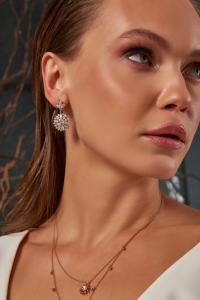The Rise of Day-to-Day Diamonds
UNITED KINGDOM, October 21, 2025 /EINPresswire.com/ -- Once considered symbols of once-in-a-lifetime events, diamonds are now slipping into everyday wardrobes. Lab-grown gems have made fine jewellery more accessible; within a decade, they have captured over half of the diamond market, while prices have declined significantly. This affordability, combined with the casual-luxury trend, means you might now spot a delicate diamond stud on a weekday or a tennis bracelet at brunch, not just on gala nights. Many jewellers have responded; brands like Glamira now feature lab-grown collections alongside fashion jewellery, reflecting this new sensibility.
Younger consumers are reshaping the diamond narrative. They want sparkle, but on their own terms. As one executive at De Beers notes, if brands are going to speak to this new generation, it cannot be a fairy tale they do not relate to. In practice, that means favouring real yet reachable gems over traditional, high-cost investments. Industry data confirm the shift; 46 per cent of US couples chose a lab-grown diamond for their engagement in the past year, up from just 12 per cent in 2019. Even once-in-a-lifetime purchases now lean towards everyday practicality.
Designers are meeting this moment with fresh ideas. John Hardy’s creative chairman, Reed Krakoff, says lab-grown stones allow creative freedom, since each gem can be entirely unique. The resulting designs were intentionally made for more casual, wearable looks. Ray Griffiths of Ratnas Paris adds, “You have to move with the times. You cannot get stuck.” Lab-grown stones, he explains, have helped him create pieces with an “extra big look” – for example, 1.5 carats per earring – without breaking the bank. The result is jewellery that sparkles boldly yet pairs easily with jeans and a T-shirt.
Casual-luxury also means jewellery in multiples. With lower per-carat costs, wearers are no longer restricted to a single heirloom ring. Merill Hollander, founder of Fiametta, puts it well: before lab-grown diamonds, a large stone had to be timeless and classic; now people buy more fun, everyday designs. You might stack pavé bands, layer huggie hoops, or style a tennis bracelet with office attire. All are real diamonds – just grown differently. Retailers say shoppers increasingly view lab-grown pieces as adaptable accessories; one even included a complimentary travel ring with each high-end purchase, signalling that lab-grown is ideal for everyday adventures, while mined stones are reserved for special moments.
Sustainability and ethics also factor into the conversation. British designer Anabela Chan, who uses recycled metals and lab-grown gems, reports strong demand for pieces that avoid mining. The lab-grown diamond market has grown by about 20 per cent annually, now driving global sales of approximately $15 billion. Even large retailers see the potential. Pandora’s head of diamonds notes that lab-grown stones open new creative possibilities, offering forms and colours once too costly in natural gems. Consumers who value transparency often prefer lab-grown options. Though both mining and lab production have environmental footprints, many see it as a matter of personal values.
Fashion media and influencers have embraced the trend. Editors at Vogue Singapore call lab-grown collections egalitarian and versatile – inclusive designs anyone can wear. Ahead of holiday and engagement seasons, they recommend tennis necklaces and dainty bracelets as standout gifts or self-treats. A jewellery box today is just as likely to hold a lab-grown ring as a mined one. UK jewellers are embracing the trend too; Glamira’s collection highlights lab-grown diamonds across engagement rings, earrings and bracelets, aligning with the casual-luxury lifestyle.
Diamonds have never felt more democratic. One industry veteran recalls that lab-grown stones once made up only 1 per cent of the market in 2015; today, it is closer to 20 per cent. “It’s coming. You can’t stop it… A diamond is a diamond, no matter how it’s made,” he says. “The market is ready. The product is ready. The consumer is listening.” From minimalist studs to gleaming tennis bracelets, the day-to-day diamond has arrived – bringing a new kind of accessible sparkle to modern life.
Selene Corvella
GLAMIRA
email us here
Legal Disclaimer:
EIN Presswire provides this news content "as is" without warranty of any kind. We do not accept any responsibility or liability for the accuracy, content, images, videos, licenses, completeness, legality, or reliability of the information contained in this article. If you have any complaints or copyright issues related to this article, kindly contact the author above.

